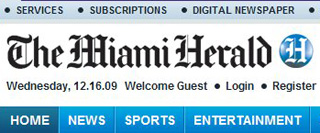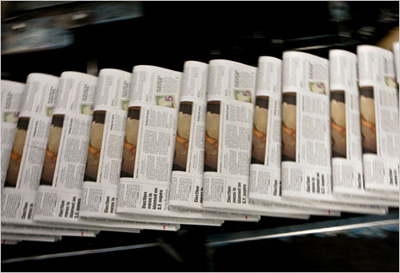|
Is
Holding Out a Tin Cup the Best Way to Monetize a Website
that Gets 5 Million Unique Visitors a Month? The Miami
Herald Will be the First to Know
|
So
it has come down to this.
In an effort to survive the historic media shift
from traditional platforms to the web, a major
metropolitan newspaper with a rich tradition has
been reduced to the electronic equivalent of
panhandling. In what may be the single best illustration
to date of |
|
the
seemingly inescapable bind newspapers find
themselves in, the Miami Herald
has started asking its website readers at MiamiHerald.com
for donations. This, even though the paper told
the Associated
Press that its site receives 5
million unique visitors a month. You would
think that with that kind of traffic,
advertisers would be falling all over themselves
to give the Herald their money. |

|
|
The
paper says the problem is that they can only
charge online advertisers about a tenth
of what their print advertisers have been paying
and that is not enough to cover their news
gathering nut (even though hundreds of employees
have been laid off in recent years). |
In
the past high paying print advertisers covered the
newspaper's expenses but with
the Herald's print circulation melting faster
than an ice cube in the Sahara desert (weekday
circulation is down almost 25% in just the past
12 months!) those high paying advertisers are quickly
disappearing. In addition to reaching fewer print
readers, one would have to assume that they don't like
the idea of paying 10 times more to advertise in
print than on the web either. It is a vicious circle
that has ensnared just about everyone in print
media. They
know that reader migration to the web is inevitable
and already well underway, but print advertising revenue
is disappearing far quicker than it can be replaced with
online ad revenue. I have always believed that the
scales will eventually balance. Advertisers want
eyeballs and eyeballs are eyeballs, whether they are
looking at an ad in print, on TV or on the web. The
question is how many in traditional media can hang on
until an equilibrium is reached?
|
On
the surface it looks like having 5 million
website visitors a month would bring things into
balance very quickly. However if advertisers are
only willing to pay 10% of their print rates
to |
|

|
reach
those web readers, that brings the equivalent
value of those 5 million web visitors down to
500,000 newspaper readers. The Herald
currently circulates nearly 5 million
newspapers a month (about 163,000 a day Monday
through Saturday and 238,000 on Sundays). So you
can see that online still kicks in only about
10% of their total revenues.
It
is true that the Herald's distribution
costs are |
|
dramatically
lower online, but newspaper readers pay
subscription fees that help offset some of the
real world distribution costs. Website visitors
pay nothing and past history indicates it is
unlikely they will ever be willing to do so. And
there's the rub. The papers will have to
continue ramping up their website traffic and
the rates they charge online advertisers. They
are in a race against time and many are losing
the race. Hence long shot experiments
like asking online readers for donations. |
I
don't think that will ever put more than a drop in the
bucket but I can't blame them for pulling out all of the
stops and trying. Though I am obviously in the online
media camp, I don't want to see the nation's great
newsrooms disappear - professional journalists are
indispensable to the health of our democracy. I am
hopeful and feel reasonably confident that the best ones
will survive the transition to the web -
and I am thankful every day that it is a transition I
made years ago. |